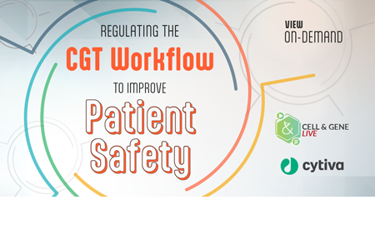Video Clips From Cell & Gene Live: Regulating The CGT Workflow To Improve Patient Safety

By Erin Harris, Editor-In-Chief, Cell & Gene
Follow Me On Twitter @ErinHarris_1

Back in August, I welcomed industry experts Mantej (Nimi) Chhina, Ph.D., J.D., RAC, Executive Director, Head of Global R&D and Regulatory Policy Global Regulatory Affairs Worldwide Research & Development at BioMarin Pharmaceutical Inc., and Robert Pietrusko, Pharm.D., Chief Regulatory & Quality Officer at Vor Biopharma to Cell & Gene Live, Regulating the CGT Workflow to Improve Patient Safety. During the 60-minute presentation, Chhina, Pietrusko, and I discussed the latest regulatory developments that impact manufacturing workflow, and therefore, efficacy and patient safety issues. You can view the full-length digital event here. But I know how busy you are, so, I broke down the 60-minute presentation into bite-size video segments for you to watch and/or listen to according to your schedule. Enjoy!
Regulatory Considerations for Scale Up
In this first segment, our experts discuss scale up to a commercial product. In doing so, they discuss the regulatory considerations for comparability, how these regulatory considerations for comparability impact patient safety, as well as how regulatory considerations impact the overall workflow for a CGT product. They also discuss how in vitro testing and biodistribution, as well as how additional clinical trial testing determines comparability of manufactured products.
Late-Stage Comparability Of The Manufacturing Process
During this segment of the presentation, Chhina and Pietrusko share the biggest hurdles biotechs face in workflows as well as ways to reduce the workflow risk. Listen in to learn what Chhina and Pietrusko discuss about workflow impact on patient safety.
In this segment, Pietrusko explains how today’s economic climate and increasing CDMO capacity affect companies and their decisions regarding manufacturing.
The FDA has issued guidance to support the development of cell and gene therapy products. There is guidance development based on commitments under PDUFA VII and CBER guidance agenda. Here, Chhina details how best to approach and support policy development in cell and gene therapy.
Real-World Evidence And Registries
In this segment, Pietrusko shares his thoughts on the use of registries and other sources of real-world data collected in clinical settings to support cell and gene therapy products development and post-approval data collection.
COAs And DHTs And Post-Approval Monitoring
In this segment, Chhina and Pietrusko share their thoughts on the use of clinical outcome assessment (COA) tools and digital health technologies (DHTs) to support cell and gene therapy product development. Later in the segment, we note that the FDA has recently held workshops on post-approval safety and efficacy data collection for cell and gene therapy products. Our panelists cover some of the key considerations for post-approval monitoring, safety and efficacy data collection, and long-term follow-up for cell and gene therapy products.
Here, Chhina explains the class-specific considerations for cell and gene therapy products that industry and regulators consider when driving policy development.
Regulating The CGT Workflow To Improve Patient Safety: Audience Q&A
At the conclusion of the presentation, our expert panelists provided detailed responses to questions from our audience. Tune in to hear their responses to questions around potential safety concerns to save time on long follow-ups on post- or pre-approvals and more.
